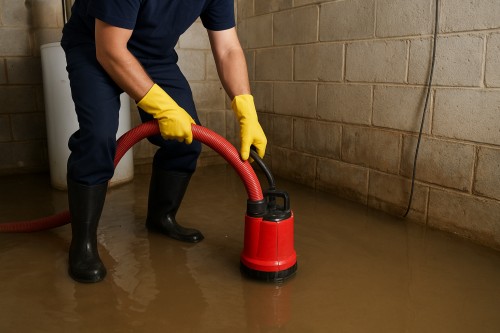A flooded basement can turn your home upside down fast. Water soaks carpets, ruins furniture, and weakens walls. If not handled quickly and correctly, the damage keeps growing. Flooded basement repair means removing water, drying everything, and fixing what’s broken so your house stays safe and healthy.
Why Basements Flood in Martinsburg Homes
Heavy rain is the main reason basements flood around here. When storms dump inches of water in a short time, the ground can’t soak it all up. Water finds cracks in foundations or comes up through floor drains.
Old sump pumps fail too. Many homes have pumps that are 15 or 20 years old. When they stop working during a big storm, water has nowhere to go. Clogged gutters and downspouts also send rain straight against the house instead of away from it.
What Happens If You Wait
Water doesn’t just sit there—it moves. It climbs up drywall like a sponge. Wooden studs swell and lose strength. Mold starts growing in hidden spots within two days. Once mold takes hold, it’s hard to get rid of and can make people cough or feel tired all the time.
A real example: One family in town ignored a small flood after a spring storm. They thought the water would dry on its own. Three weeks later, their basement smelled bad and the floor felt soft. The repair bill jumped from $4,000 to $12,000 because mold had spread behind walls.
Step-by-Step Repair Process
Step 1: Get the Water Out Fast
Professionals use strong pumps to suck water out. They don’t stop at the surface—special tools pull water from under carpet and padding. Every gallon removed early saves hours of drying later.
Step 2: Dry Everything Completely
Big fans and dehumidifiers run for days. Workers check moisture in walls and floors with simple meters. Wood needs to be bone dry before anything goes back together. Skipping this step leads to warped floors and peeling paint later.
Step 3: Throw Out What Can’t Be Saved
Wet drywall usually gets cut out 12 to 18 inches above the water line. Insulation soaks up water like a sponge and never dries right, so it goes in the trash. Furniture with particle board swells and falls apart—solid wood pieces sometimes survive if dried fast.
Step 4: Clean and Prevent Mold
Safe sprays kill any mold spores left behind. These aren’t harsh chemicals—just products made for homes. Everything gets wiped down so nothing grows back.
Checking the Foundation
Water pressure pushes hard against basement walls. Too much water can crack blocks or bow walls inward. Foundation repair experts look for new cracks or leaning walls after a flood. Small fixes now stop big problems later.
One homeowner found a 6-inch crack after a flood. A quick fix with steel braces cost $2,500. Waiting would have meant replacing the whole wall for $15,000.
Cleaning the Air System
Flood water gets into heating and cooling ducts. When the furnace turns on, it blows damp air and bad smells upstairs. Air duct cleaning Martinsburg WV removes mud, mold, and debris so your family breathes clean air again.
Smart Basement Systems to Stop Future Floods
Basement systems Martinsburg WV include simple upgrades that work:
- Better sump pumps with battery backup keep running even if power goes out.
- Interior drains around the basement floor catch water before it spreads.
- Wall liners guide water down to drains instead of letting it soak in.
- Dehumidifiers keep the air dry all year so mold can’t grow.
These systems cost a few thousand dollars but save tens of thousands in repeat damage.
Real Stories from Local Homeowners
Sarah’s basement flooded twice in one year. The first time, she hired a cheap crew that just pumped water and left. Mold came back in a month. The second time, she chose a company that dried everything, cleaned ducts, and added a new sump system. No problems since—even during the big storm last summer.
Mike waited a week to call for help. By then, his floor joists were soft and his water heater rusted out. Total cost: $18,000. His neighbor acted the same day water came in and paid $6,000 for full repair and prevention.
Choosing the Right Help
Look for companies that:
- Show up the same day you call
- Explain every step in plain words
- Give a clear price before starting
- Offer warranties on their work
- Know local homes and weather patterns
Simple Prevention Tips
- Clean gutters every spring and fall.
- Extend downspouts 5–10 feet from the house.
- Test your sump pump monthly—pour a bucket of water in and watch it work.
- Grade soil away from the foundation so water flows downhill.
- Keep valuables in plastic bins off the floor.
The Cost of Doing It Right
A full flooded basement repair with drying, cleaning, and prevention runs $5,000 to $10,000 for most homes. That sounds like a lot, but it’s cheaper than:
- Replacing all your furniture
- Fixing sagging floors upstairs
- Paying medical bills for breathing problems
- Losing your home to major structural failure
Your Home Can Bounce Back
Water damage feels overwhelming, but basements can be saved. The key is acting fast and doing the job completely. Remove water, dry thoroughly, fix what’s broken, and add protection. Your basement can end up stronger and drier than before the flood.
Take it one step at a time. Start with a call to a trusted local team. They’ll walk you through exactly what needs to happen so you can use your basement again—without worry every time it rains.



